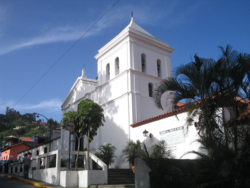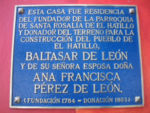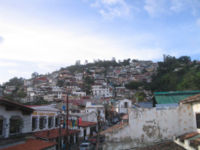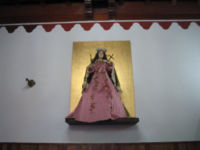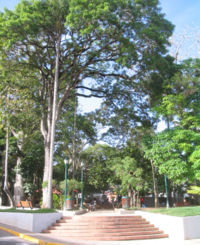El Hatillo Municipality, Miranda
2007 Schools Wikipedia Selection. Related subjects: Central & South American Geography
| El Hatillo Municipality, Miranda | |||||
| Santa Rosalía de Palermo Church | |||||
|
|||||
| El Hatillo Municipality in Miranda State | |||||
| Coordinates: | |||||
|---|---|---|---|---|---|
| Country | Venezuela | ||||
| State | Miranda | ||||
| Seat | El Hatillo Town | ||||
| Founded | June 12, 1784 | ||||
| Incorporated | November 9, 1991 | ||||
| Mayor | Alfredo Catalán Schick | ||||
| Political party | Project Venezuela | ||||
| Area | |||||
| - City | 114 km² (44 sq mi) | ||||
| Elevation | 1136 m (3730 ft) | ||||
| Population | |||||
| - City (2001) | 54,225 | ||||
| - Density | 475.66/km² (1,232.39/sq mi) | ||||
| Time zone | AST ( UTC-4) | ||||
| Postal codes | 1083 and 1061 | ||||
| Area code(s) | 212 | ||||
| Website: http://www.elhatillo.gov.ve | |||||
El Hatillo Municipality (Spanish: Municipio El Hatillo) is an administrative division of the State of Miranda, Venezuela, and along with Baruta, Chacao, Libertador and Sucre, it is one of Caracas' five municipalities. It is located in the southeast area of Caracas and in the northwest part of Miranda.
The seat of the municipal government is El Hatillo Town, founded in 1784 by Don Baltasar de León, who also participated in the development of the region. Although the town had its origins during the Spanish colonization, it was not until 1991 when the municipality was established. In 2000, the year after a new constitution was introduced in Venezuela, some of the powers of the municipality were delegated to a mayor's office called Alcaldía Mayor which also took control over the other four municipalities of Caracas.
El Hatillo still preserves some of its colonial architecture, including an 18th century parish church, therefore, it is a place of interest for visitors to the city. The municipality receives a part of its income from tourism; music festivals, art expositions and other cultural events are held in the municipality. Even though commercial areas are growing fast, agriculture still remains as an economic income in the rural areas of the municipality, which still represent the southern part of El Hatillo.
History
In the 16th century, when the Spanish colonization in the area began, El Hatillo was inhabited by the indigenous tribe Mariches, descendants of the Caribs. Cacique Tamanaco was the leader of these tribes at the time. He is known for resisting the Spanish colonization, but very little is written about the origins of the Mariches. As the colonization developed, the indigenous habitants were killed. By orders of Caracas' founder Diego de Losada, Tamanaco was also murdered.
Around 1752, Don Baltasar de León García arrived to El Hatillo from Cádiz, Spain, after completing his years as a prisoner at La Carraca for participating with his father in an insurgency against the Guipuzcoana Company. Don Baltasar founded El Hatillo Town, and he was one of the most significant contributors to its development at the time. Don Baltasar focused on making El Hatillo a strong, united and independent community. Don Baltasar tried to establish the place as a different parish from Baruta. On June 12, 1784, he accomplished this when the governor and the bishop agreed to declare the autonomy of El Hatillo in front of 180 Canary-descendant families, and under the direction of Don Baltasar. This date is currently accepted as the foundation of El Hatillo Town.
In 1803, Don Baltasar and his brother-in-law donated their properties to urbanize the town. An engineer took care of the job, which included grid streets and a parish church, built in honour to Santa Rosalía de Palermo, who had supposedly saved Baltasar from a plague that killed his father in prison.
In 1809, Manuel de Escalona achieved the separation of El Hatillo from Petare, another suburb of Caracas, making it a different Tenientazgo de Justicia. On April 19, 1810, Escalona incorporated the town to the movement of independence, becoming another important person in the municipality.
Ana Francisca Pérez García, Don Baltasar's wife, was also a significant woman in El Hatillo. She was caring with children, elders and ill citizens. Ana Francisca donated a considerable amount of money for the construction of a hospital in Petare after the 1812 earthquake. This hospital is currently known as the Pérez de León de Petare Hospital.
Although El Hatillo was independent from Petare since 1809, it became part of Sucre Municipality at some point, which is where Petare is located. It is unclear how so happened, but on November 19, 1991, Miranda's Legislative Assembly gave El Hatillo full autonomy, making it an independent municipality. This decision was issued in Gaceta Oficial on January 17, 1992. In 1993, Mercedes Hernández de Silva was elected the first mayor of El Hatillo, who took charge until 1996, when Flora Aranguren was elected mayor. On 2000, Alfredo Catalán Schick was elected, and then re-elected in 2004 for another four-year term.
Geography
El Hatillo Municipality is located at the northwest corner of the State of Miranda and at the southeast area of the city of Caracas. It is one of the state's 21 municipalities. El Hatillo is within the jurisdiction of the Alcaldía Mayor, which has power over three other adjacent municipalities of Miranda, and over Libertador Municipality in the Capital District. These five municipalities make up the city of Caracas. El Hatillo has a land size of 114 km², making it the third largest municipality in the capital. The municipality is located at the Serranía del Interior, a mountain range parallel to the Coastal Range, which spans east-west. The Turgua Range provides a natural boundary for the south of the municipality. El Hatillo limits north with Sucre and Baruta, south with Baruta and Paz Castillo, east with Sucre and Paz Castillo, and west with Baruta. The main streams in the municipality are Tusmare, at the centre of El Hatillo, and Prepo near the southern edge.
The tallest peak in El Hatillo is Picacho de El Volcán, at 1,490 m over sea level, where many radio, television and telecommunication antennas serve Caracas. Despite its name, which in Spanish means "Peak of The Volcano", the mountain has no recorded volcanic history. Other significant mountains in El Hatillo are Gavilán (1,148 m), Topo de El Paují (1,245 m) and Topo de Piedras Pintadas (1,196 m).
Climate and environment
El Hatillo has a slightly cooler weather than downtown Caracas, which is caused by the higher altitude of the municipality. The average temperatures are between 21 and 24 degrees Celsius (70-75 °F). In the highest elevations of the municipalities the temperature can decrease to 18 °C (64 °F) and the atmosphere may have constant fog. The mean precipitation is 997.3 millimeters a year; annual values can range from 800 mm to 1500 mm. The average humidity index is 75%, and like in the rest of the country, the months of May through November belong to the rainy season while all other months correspond to the dry season. The winds are north alizé trade winds.
The vegetation of El Hatillo is formed by dense forests in most of the municipality. Trees occupy 30% of the surface along water bodies. Smaller plants like shrubs take around 9% and herbs occupy a similar percentage. In 1972, the forests of El Hatillo were declared protected zone of the metropolitan area of Caracas. The municipality is home for a wide range of bird species, with more than two hundred of these animals registered, including various types of sparrowhawks, eagles, falcons, and owls. This has encouraged birdwatching in the area, an activity that is promoted by the authorities of Miranda, who have also supported conservation of the species.
Demographics
According to the 2001 census made by the National Institute of Statistics, El Hatillo Municipality has a population of 54,225 inhabitants. 2000 data from the same institute states that 9.52% of El Hatillo's population are from ages 15 to 19. Regarding gender, for every 100 females there are 94.2 males. The unemployment rate (2000) is 22.7%. The main cause of death (1999) is cancer, followed by heart diseases and violent deaths.
Prior to the Spanish colonization, El Hatillo was inhabited by Mariches, a native tribe related to the Caribs. In the 16th century the indigenous inhabitants were killed by the explorers. When the development in El Hatillo began, Spaniards coming from the Canary Islands settled in the area. Similarly, families from Madeira, Portugal, immigrated to El Hatillo. With the progressive demographic increase, El Hatillo is not exclusive to any particular ethnic group.
Neighborhoods
Even though there are no defined limits for the neighborhoods of El Hatillo, the government website divides the municipality into urban and rural. Concentrated in the northern region of the municipality, the urban neighbourhood are El Hatillo Town, El Calvario, La Lagunita, Alto Hatillo, La Boyera, Las Marías, Oripoto, Los Pomelos, Los Naranjos, Los Geranios, La Cabaña, Cerro Verde and Llano Verde, Colinas, Vista El Valle, Los Olivos, and El Cigarral. The rural localities of the municipality are located in southern El Hatillo. These are La Unión, Corralito, Turgua, La Hoyadita, Sabaneta, La Mata, Caicaguana, Los Naranjos and Altos de Halcón.
Economy
The economy of El Hatillo Municipality can be broken down in three sectors: the commercial sector, which has been growing along with the demographic increase and is primarily represented by shopping malls and stores around the urban areas of the municipality; agricultural, in the southern half of the municipality and existing since the founding of El Hatillo; and tourism, which contributes significantly to El Hatillo's income and is promoted by the government.
El Hatillo is a day visit for people in Caracas; the municipality is close to downtown, therefore, the place has been focused for tourism. Plaza Bolívar and its surroundings are very well maintained, additionally, the municipality government offers bus trips around the narrow streets of the town, showing people the colonial architecture. Handcrafted souvenirs are sold well. Hansi, a very popular shop offers all kinds of handcrafted products. There are at least three cultural centers in the municipality that attract tourists and residents to music festivals and art expositions. See activities and recreation below for more information.
Businesses in the municipality are almost strictly commercial. This fact has been taken as a cause of the high traffic in El Hatillo; those seeking employment within the municipality will have a better chance of finding one under commercial activities, but for office jobs, citizens need to look outside El Hatillo. This status of office underdevelopment has been attributed to several issues, there is no room for large scale office constructions, and for terrains available, the costs go very high.
Due to the increasing population, extensive shopping malls have been recently built in the municipality. Neighborhoods like La Lagunita, Los Naranjos and El Hatillo Town now offer large scale shopping malls with multiplex movie theaters, and the old typical houses of El Hatillo Town have been converted to shops, while preserving their colonial look. El Hatillo also receives income from agriculture.
Law and government
The law of Venezuela specifies that municipal governments have four main functions. The executive function is managed by the mayor, who is in charge of representing the municipality's administration. The legislative branch is represented by the Municipal Council, formed by seven councillors. This entity in charge of the deliberation of new decrees and local laws. The comptrolling tasks are managed by the municipal comptroller's office, which is in charge of the revision of accountancy. Finally, planning is represented by the Local Public Planning Council, whose job is of managing projects for the development of the municipality.
The president of the Municipal Council is Leandro Pereira, supported by the political party Justice First. All but one of the seven councillors belong to parties opposed to President Hugo Chávez's administration. Additionally to the authorities mentioned before, there is a Legislative Commission, currently presided by councillor Salvador Pirrone. The commission's job is to assist the municipality in legal matters, like the creation of new laws and decrees.
In March 8, 2000, the year after a new constitution was introduced in Venezuela, it was decreed in Gaceta Oficial N° 36,906 that the Metropolitan District of Caracas would be created, and that some of the powers of El Hatillo would be delegated to the Alcaldía Mayor, which would also start governing the Baruta, Libertador, Sucre and Chacao municipalities. Venezuelan municipalities are subdivided in parishes. Unlike other municipalities, El Hatillo only has one, the Santa Rosalía de Palermo Parish, sometimes denoted as Santa Rosalía de El Hatillo Parish or simply El Hatillo parrish.
El Hatillo has had three mayors so far. From 1993 until 1996, Mercedes Hernández de Silva was the first mayor of the municipality. Following that, Flora Aranguen served from 1996 until 2000. That same year, Alfredo Catalán was elected mayor. In 2004 he was reelected; his term is set to end in 2008.
Catalan's administration
In 2001 the mayor stated that his main goal for the municipality was to promote it as a touristic destination. In fact, Catalán's first year in office was focused on improving the appearance of the municipality, and the El Hatillo Independent Institute of Tourism and Recreation was created. Operation Joy (Spanish: Operación Alegría), a project that attempts to make the municipality cleaner and nicer, has been in action during Catalán's government.
According to the municipality website, the current government has made improvements to the educational facilities of the area, including the repair of five state-owned schools that support 1,400 students. Special programs have been implemented for students, such as drug prevention, water conservation, the Francisco de Miranda Project, which suggests the use of technology to improve children's education, and other programs that also benefit the municipality by getting citizens more involved in the community activities.
In terms of health, El Hatillo houses the Jesús Regetti Ambulatory, where citizens from inside and outside the municipality receive medical attention. According to the municipality, in 2004, 50,000 citizens of all ages benefited from this medical facility. The government claims that crimes that occur in El Hatillo only represent 1% of the crimes in Caracas. However, citizens criticize the municipality's insecurity and are unsure about the quality of health services and educational institutions. Read criticism below for more information.
Criticism
Some individuals, such as the journalist Nelson Bocaranda, have criticized the municipal government regarding its insecurity. Several examples that support Bocaranda's criticism exist. In early March 2006, two 24 and 25 years old men were gunned down after leaving a party at two o'clock on a Sunday morning. On March 11, a 30 year old and a teenager died after being gun-shot 30 times at El Calvario neighbourhood. Bocaranda himself was a victim of death threats after criticizing Catalán's administration in his radio emission Los Run Runes de Nelson. According to the IFEX, the mayor's father Norberto Catalán, went to Bocaranda's office in La Lagunita with his bodyguard. Bocaranda was not in his office at the time, but his secretary was told that Norberto was armed and he would shoot the journalist if he did not take his comments back within 24 hours. The mayor's father also left threatening notes. A security video camera recorded the incident.
Violence is not be the only problem, since some other governmental shortcomings are also apparent. Urban planning has been insufficient, the demographic increment in recent years has caused the traffic to collapse during rush hour, and the public services are insufficient in some areas. Neighbors claim that public schools are in a bad state and that many students cannot attend classes due to socioeconomic problems. Likewise, citizens have alerted the media that health services are mediocre in the municipality.
Bankruptcy
In 2001, Alfredo Catalán mentioned in several occasions that the municipality was bankrupted. He said to the media that a lot had been done for El Hatillo for a first year in office, and since the beginning of his fist term, Catalán had given priority to tourism. Between the five municipalities of Caracas, El Hatillo receives the least income from taxes, but he believed that Operation Joy would give the residents trust in the mayor, and more investments have been done in culture and tourism than in a new local government headquarters for example. Catalán denounced that Flora Aranguren, the previous mayor, had left a deficit of almost US$500,000 between budget and treasury.
Education
El Hatillo offers free public education. There is a total of seventeen primary education schools, in which eleven are public and six are private. Nineteen preschools exist, ten public and nine private. Data for secondary education is incomplete. It is only known that five private secondary schools exist in the municipality, but the number of public schools of this kind is unavailable. Note that the the data presented shows each educational stage separately, but a one facility may contain preschool, primary and secondary education.
The municipality has only one higher education facility, Nueva Esparta University. This three ha institution located in Los Naranjos began as a project with the creation of Nueva Esparta school in 1954, but it was not until 1989 when the university was constructed. This university is privately owned.
Transportation
The methods of transportation in the municipality are basically private vehicles and road public transportation. The geographic features of El Hatillo have made it hard to extend the Caracas Metro to southeast Caracas. A long range line of the metro known as Line 5 (Magneta) has been proposed, but likely due to the geographic characteristics of southeast Caracas, it has not been constructed. The municipality's latest urban planning has been unorganized. News archives show that at least since 1998, neighbors have been complaining about the dense traffic caused by new residential and commercial constructions. New or enhanced alternative roads that will definitely fix the problem have not been finished. A south beltway suggested 25 years ago has not been constructed due to high costs. However, as of January 2006, a new route that will connect La Lagunita with Macaracuay—a neighbourhood in northeast Caracas—is under construction and it is planned to be finished in 2010. According to Catalán, 23% of El Hatillo's inhabitants will eventually use this transit way.
Even though local solutions, such as the ones mentioned above, may improve the traffic congestions that affect El Hatillo, the traffic issue is a large scale problem that affects the whole city. It is estimated that one million vehicles transit Caracas on a daily basis, making the transportation networks "collapse." The average speed of automobiles is 15 Km/h. Several causes for this problem have been given. According to the Venezuelan Society of Transportation Engineers, an organized city should give 20% of its public spaces to transportation; in Caracas, less than 12% of these areas are given for transit purposes. From 2001 to 2006, 250 000 new cars were sold in Caracas. Only in 2004, 50 000 vehicles were sold. In 2005, this number increased to 60 000, and as of November 2006, 70 000 cars have been sold since the year began. Public transportation is not fully reliable, an average trip in the city using mass transit takes around 90 minutes.
Culture
The most significant icon of El Hatillo culture is Santa Rosalía de Palermo. Today, the church of El Hatillo Town is named after this saint, and the only parish in the municipality also has her name. The locals believe that Rosalía takes care of the people. The community is largely Catholic; handcrafted products in shops are religious, and the municipality holds the Santa Rosa de Lima Seminary, formerly San José Seminary. Like in the rest of Venezuela, in El Hatillo, the images of Jesus and Mary have become part of the art and culture.
Don Baltasar de León is remembered for founding and developing El Hatillo, so is his wife Ana Francisca. Manuel Escalona is recognized for including El Hatillo in the movement of the independence in the 19th century, as in the whole nation Simón Bolívar is considered a hero.
Heritage
Rosalía is the patron saint of El Hatillo, she was born in Palermo, Italy in 1130. Rosalía was first recognized in 1624 when a horrible plague haunted Palermo. Santa Rosalía appeared to many, and she became the patron of Palermo for saving many from the plague.
Years later, El Hatillo's founder believed too that Santa Rosalía protected him from an infection. During the Guipuzcoana scandal in Venezuela, Baltasar's father Juan Francisco de León and his sons were held prisoner in Cádiz. Juan Francisco died as a consequence of smallpox, but Don Baltasar completed his years in prison and then moved to El Hatillo, bringing the legacy of Santa Rosalía de Palermo to El Hatillo, saying that she protected him from the pestilence that killed his father in Cádiz.
Consequently, El Hatillo's culture has grown around its most important patron, Santa Rosalía is believed as the one who takes care of the people, she protects everyone from any pandemic that could hit the area. It was Don Baltasar who incorporated Rosalía to the culture of El Hatillo. In 1766 the first chapel—now in El Calvario neighbourhood—was built in El Hatillo, but in 1784 a bigger parish church was built, which was named Iglesia Santa Rosalía de Palermo.
Art and music
At the present there are frequent cultural events that revive the history of El Hatillo. The Cultural and Social Center El Hatillo, El Hatillo Art Centre and El Hatillo Atheneum are the places where most activities take place. Every year around the town's anniversary, the municipality's past is relived through the International Music Festival of El Hatillo and El Hatillo Week. There are also art galleries with frequent expositions. Holidays—whether they are nationwide or local—are always celebrated, and every September El Hatillo remembers Santa Rosalía de Palermo.
El Hatillo is home for performances from national and international musicians. In November 2005, the 7th El Hatillo Jazz Festival took place, a ten-days event that brings many visitors to the municipality to hear the notes from the best national Jazz artists. In April 1, 2006, Dave Samuels inaugurated a music festival in El Hatillo Art Centre. Samuels was followed by Simón Díaz, Steve Smith, Serenata Guayanesa, Mike Stern and other famous musicians in an event that was being held almost every Saturday until August 5.
In May 2005, the local government and the Japanese Embassy organized the Japan Cultural Week, an exposition held in the Art Centre featuring bonsai, origami, kimonos, martial arts, anime and other manifestations of the Japanese culture. The event offered free workshops for learning these Japanese arts. Continuing cultural promotion in the municipality, in October 2005 the III Salón de Fotografía El Hatillo was organized, a photography contest for children, amateur and professional photographers.
Sports
El Hatillo people also enjoy doing sports. La Lagunita Country Club is a very exclusive golf course in the wealthiest neighbourhood in El Hatillo. This is not the only sport alternative however. Polideportivo La Boyera, a public sport center in La Boyera neighbourhood, offers a baseball field, tennis courts, a multi-court, karate, aerobics, summer camps and other activities for the community at low rates and free of charge in some cases.
Tourism and recreation
The hub of activity in El Hatillo is Bolívar Plaza (Spanish: Plaza Bolívar), a garden square encompassing the central block in the town of El Hatillo. Constructed in 1785, the Plaza was originally called Plaza Mayor or Plaza del Mercado. In 1911, a bust honoring Manuel Escalona was placed in the square, which was renamed in his honour. In 1952, the bust was replaced with a statue of Simón Bolívar, and the plaza was again renamed, after the Venezuelan hero. Across from the Bolívar Square is the 18th-century Santa Rosalía de Palermo Church, which was declared a National Historic Monument in 1960.
Between El Hatillo and La Lagunita is the smaller Manuel Escalona Plaza (Spanish: Plazoleta Manuel Escalona), another urban monument displaying the bust of Escalona that formerly occupied Bolívar Square. Sucre Plaza (Spanish: Plaza Sucre)—graced since 1915 with a ceiba tree at its centre—is in the southern part of town; this was historically where people tied their mules while frequenting The Four Corners. The Four Corners (Spanish: Las Cuatro Esquinas) was a convenient social gathering spot in El Hatillo, comprising a general store, hardware shop, gambling place and bar.
La Lagunita is the site of one of the 15 Romanian Orthodox Churchs in the world since the widespread destruction of churches by the Ceacescu regime in Romania: the San Constantino and Santa Elena Romanian Orthodox Church. Only two of these churches are outside Romania, the other being in Switzerland. The building is an architectural work from the 16th century, brought from Romania, made completely from oak and fir woods, and detailed with more than 40,000 individually placed and carved tiles.
For children, the Caicaguana hacienda in La Lagunita houses the Expanzoo, where visitors can see and touch exotic animals. The zoo is recognized for offering unique employment opportunities; the workers are from families with few resources, and the staff include the mentally ill. The Baby Zoo is a place for children to interact with animals; visitors can feed and touch the animals, ride horses and hire the location for special events. The Morro la Guairita National Park in El Cafetal—commonly known as the Indian Caves (Spanish: Cuevas del Indio)—is a system of 22 natural openings in the mountain, and the only place in Caracas where rock climbing is allowed. Guided tours are available, and views of El Ávila can be enjoyed while ascending the park.
